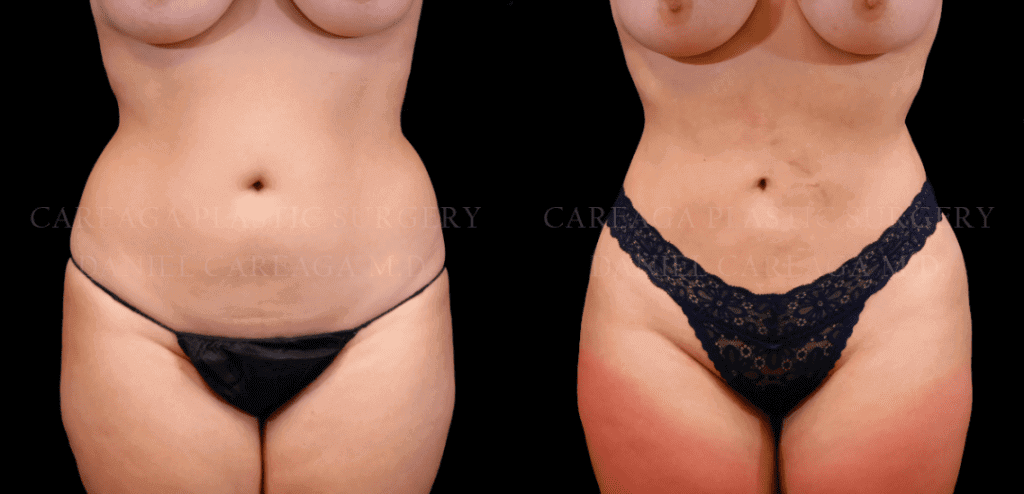4 Things to Expect With Liposuction
Posted June 03, 2019 in Liposuction
Liposuction can be performed on the abdomen, hips, thighs, buttocks, back, calves, ankles, arms, neck, and chin to eliminate stubborn fat deposits. This minimally invasive surgical procedure offers the safe and effective removal of unwanted fat and provides long-lasting results.
But what exactly are you getting into when you decide to undergo liposuction? Here are the answers to four of the most commonly asked questions about liposuction:
1. What Are Your Liposuction Options?
At its core, liposuction is the process of using a vacuum device to suction out fat cells through a hollow instrument called a cannula, which is placed under the skin to loosen and remove unwanted fat.
While liposuction in itself is a simple process, there are many variations of the procedure, including:
Tumescent Liposuction
Tumescent liposuction injects a saline solution into the fatty layer of tissue before the cannula is inserted. This solution causes the tissues in the treatment area to swell and the blood vessels to shrink, which allows Dr. Careaga to have better control over the fat removal process. Tumescent liposuction also reduces the amount of blood loss, which helps to reduce post-operative bruising, swelling, and pain.
VASER LipoSelection®
VASER LipoSelection® uses ultrasound technology to break up and emulsify the fat before the cannula is inserted. By liquifying the fat, it can be removed with much more ease and will leave the surrounding tissues, nerves, and blood vessels untouched. During VASER LipoSelection®, the ultrasound probe emits high-frequency sound energy to break up the fat and prepare it for removal. This technique offers less post-operative bruising and swelling and can also provide tightening for various areas of the body.
Smartlipo™
Like VASER LipoSelection®, Smartlipo™ breaks apart and liquefies the fat for easier removal. This laser-assisted option inserts a fine laser fiber into the fat layer where it delivers thermal energy to the cells. This energy melts the fat before it is removed with gentle suction. This technology minimizes bruising and swelling and can allow for more precise body contouring.
2. What Can You Expect During Your Liposuction Recovery?
Regardless of the techniques used, you can expect to experience some swelling, bruising, and numbness in the treatment areas. Support bandages or compression garments should be worn over the incisions to relieve pain and inflammation during the first few days of recovery.
These garments will help to promote blood flow, which will decrease your risk of infection and blood clots. You should also try to get on your feet as soon as possible to promote healing. The majority of the swelling, bruising, and numbness should subside within four weeks; however, it may take six to eight weeks to completely dissipate.
3. Is It True That Fat Moves to Other Locations After Liposuction?
There is a common myth that the fat removed through liposuction transfers to another area of the body. This is not true. Liposuction removes fat cells, and those cells are gone for good—they do not travel to another region. The reason that this rumor has gained so much traction over the years is that the untreated areas are more prone to weight gain than areas that were treated with liposuction.
Every individual is born with a certain number of fat cells that cannot increase or decrease unless you undergo liposuction. When you gain weight, you are not increasing the number of fat cells in your body; instead, you are expanding the size of those cells. The same goes for weight loss.
This is what differentiates liposuction and traditional weight loss: liposuction alters the number of fat cells present in the treatment areas. So, if you gain weight after liposuction, there will not be as many fat cells in the treated region to absorb the newly formed fat. This fat will, however, need to go somewhere, so it accumulates in the untreated areas.
Fat is not transferred after liposuction—it develops in the regions with the highest number of remaining fat cells.
4. Is Liposuction for You?
Liposuction is not a substitute for weight loss or an answer to obesity. It will not remove stretch marks, cellulite, or dimples. Liposuction is a cosmetic procedure that trims and sculpts bodies that are near their ideal weight and have good skin elasticity.
If you have a significant amount of excess weight or are concerned about weight gain after the procedure, you should try to lose weight naturally before you undergo liposuction. This will allow you to get your health on track so that you will be able to maintain your results after the procedure.
By maintaining a stable weight and following a healthy lifestyle, you can enjoy your liposuction results for years to come.
Contact Us Today!
For more information about liposuction and any of the liposuction techniques offered, contact Careaga Plastic Surgery by calling (305) 960-7511 or by filling out our online contact form. Dr. Careaga and his team of specialists look forward to assisting you will all of your body contouring wishes.

